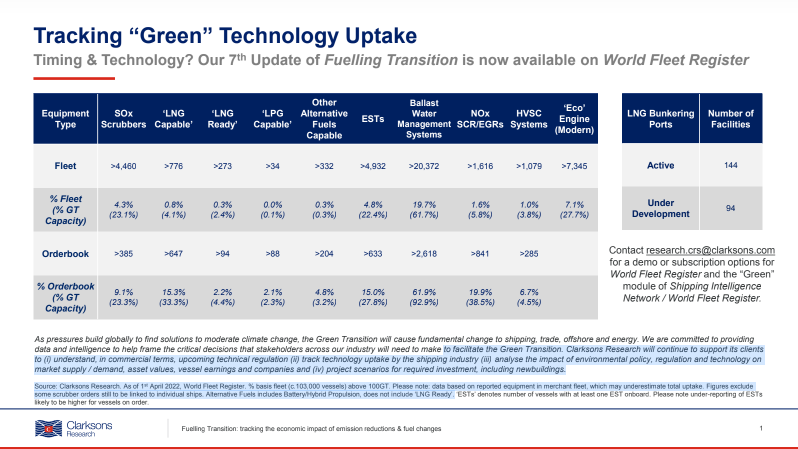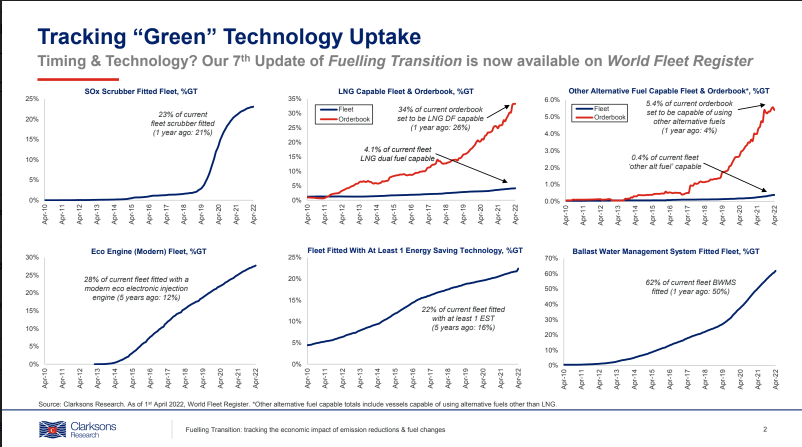Press Release: As emissions regulatory and policy decisions continue to “ramp up” across maritime, Clarksons Research is closely tracking uptake of “green” technology that will impact the shipping industry’s 883mt (2008: 1,028mt) and 2.4% contribution to global CO2 (and 1.8% of all GHG). Reviewing data points and latest trends in technology uptake and fleet renewal extracted from our upcoming Fuelling Transition (available soon, please contact research.crs@clarksons.com ), Steve Gordon, Clarksons Research Managing Director, commented:
A record 61% share of all orders in Q1 were alternative fuelled: excluding LNG carriers the share was 48% and 10% of all orders were both LNG fuelled and Ammonia Ready
- In Q1 2022, a record 61% of tonnage ordered was alternative fuelled (excluding LNG carriers this was still an all-time high at 48% of orders by tonnage). 57% of orders by tonnage (101 orders of 9.3m GT) were LNG fuelled, with 3.4% methanol fuelled (4 orders of 0.6m GT), 0.6% of orders ethane fuelled (2 of 0.1m GT), and 0.7% included battery hybrid propulsion. A further 12% of orders were “Ammonia Ready” (26 orders of 2.0m GT), 1.4% “LNG ready” (10 orders of 0.2m GT) and 0.1% of orders were “hydrogen ready” (3 orders of 15k GT). Please note these add up to excess 100% of the alternative fuels capable total due to an increasing trend towards multiple fuels / fuel ready to provide future optionality (In Q1, 10% of orders were LNG fuel plus Ammonia Ready). For context, in 2021 32.7% of newbuild tonnage ordered was for alternative fuel capable vessels (449 units), up from 209 orders in 2020 and 46 orders in 2016.
4.5% of fleet and 38% of the orderbook tonnage now alternative fuelled
- Uptake of alternative fuels has continued to progress, with 4.5%* (2021: 3.9%, 2017: 2.2%) of the fleet on the water and 37.8% (2021: 27.8%, 2017: 11.8%) of the orderbook in tonnage (GT) terms capable of using alternative fuels or propulsion. We are projecting that 5% of global fleet capacity will be alternative fuelled by the start of 2023.
- Of the orderbook, 33.3% of tonnage is set to use LNG (647 units), 2.3% to use LPG (88 units) and 3.2% due to use other alternative fuels (c.200 units; including methanol (24), ethane (11), biofuels (5), hydrogen (6) and battery/hybrid propulsion (c.150)).
- Over 270 ships in the fleet and 94 on the orderbook are designated “LNG ready”, while there are now 74 “Ammonia ready” and 9 “Hydrogen ready” vessels on order.
*in numerical terms this is ~1%.
23% of global tonnage scrubber fitted and 28% of tonnage now “eco”; record “fuel bill” for shipping projected in 2022
- Scrubbers are now fitted to over 4,460 ships in the fleet (23.1% of total GT). While scrubber retrofitting activity has slowed (March 2020: ~120 per month, March 2022: ~20 per month), newbuild uptake grew slightly in 2021, with 249 newbuild orders for scrubber-fitted units reported across the full year, including 194 containerships; 14 scrubber fitted units have been ordered in 2022 so far. The current price differential between HSFO and VLSFO is almost $300/t, close to previous highs (Jan 2020: ~$330/t). We expect the share of global tonnage with a scrubber to grow marginally to 24% by start 2023.
- Energy saving technologies (ESTs) have been fitted on over 4,900 ships, accounting for 22.4% of fleet tonnage: including propeller ducts, rudder bulbs, Flettner rotors, wind kites and air lubrication systems.
- ‘Eco’ ships make up a growing share of the fleet (‘modern’ eco vessels now 27.7% of total GT) with implications for earning potential, asset values and increasingly “tiered” and complex charter markets. For context, we estimate that 25.1% of global tonnage was “eco” twelve months ago, compared to 11.5% five years ago and a projection of ~30% of global tonnage by start 2023. Besides emissions, we expect a record fuel bill for shipping in 2022 (excess $200bn) to also increase demand / premiums for fuel efficient tonnage.
Average age of fleet increasing, newbuilding orderbook still only 10% of the fleet
- The average age of the world fleet is increasing. For the bulk carrier fleet it is 11.3 years (vs 8.7 years five years ago), for tankers it is 11.8 years (2017: 10.2 years) and for the container fleet it is 13.8 years (2007: 10.6 years). 27% of global tonnage is today aged over 15 years. We estimated that under CII, around 29% of today’s tanker, bulkcarrier and container fleets would be D or E rated in 2023 rising to over 40% if they are still trading in 2026 and have not modified speed or specification.
- The overall orderbook as a % of fleet capacity is ~10% : the figure is 26.4% for containers, 6.6% for bulk carriers and 6.3% for tankers.
- ‘Green’ port infrastructure is continuing to expand: currently 144 active LNG bunkering ports (and 94 planned facilities), while over 1,364 vessels fitted/set to be fitted with shore power connections; Clarksons Research are also collecting data on ammonia and hydrogen infrastructure.
- BWMS retrofit programme ongoing: majority of fleet tonnage (61.9%) now BWMS-fitted.
As pressures build globally to find solutions to moderate climate change, the Green Transition will cause fundamental change to shipping, trade, offshore and energy. We are committed to providing data and intelligence to help frame the critical decision s that s takeholders across our industry will need to make to facilitate the Green Transition. Clarksons Research will continue to support its clients to (i) understand, in commercial terms, upcoming technical regulation (ii) track technology uptake by the shipping industry (iii) analyse the impact of environmental policy, regulation and technology on market supply / demand, asset values, vessel earnings and companies and (iv) project scenarios for required investment, including newbuildings. See our latest Fuelling Transition report for full details.


Clarksons Research, the data and analytics arm of Clarksons, are market leaders in the provision of independent data and intelligence around shipping, trade, offshore and energy. Millions of data points are processed and analysed each day to provide trusted and insightful intelligence to stakeholders across maritime.































